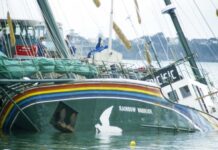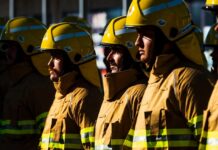Kazu Nakagawa is used to sourcing materials from far and wide but the spread of input for the Waiheke artist’s latest work is truly global in scope.
Carving Water Painting Voice, Nakagawa’s visual and sound installation for headland Sculpture on the Gulf 2017, combines material originally from Niue, the Solomon Islands and New Zealand with musical and voice contributions from migrants around the world.
The Niuean connection is a small outrigger canoe which was brought back to New Zealand as a gift. But it had fallen into serious decay when members of the Waiheke Waka Ama Club suggested he might do something with it.
The migrant voices include Nakagawa himself, who arrived in New Zealand from Tokyo in 1996 and has called Waiheke home since 1998.
Together with composer Helen Bowater, his sound collaborator for the work, and his filmmaker son Ku, who lives in Korea, vocal and musical input was obtained from New Zealand, Iraq, Syria, France, Italy, Israel and South Korea.
But Nakagawa was really scratching for one vital element – paddles – for the deeply metaphorical work until he found the solution right under his nose: leftover timber battens from his design for the facade of the Waiheke Community Library in Oneroa, which opened in 2014. The battens, sourced from hardwood plantation forest in the Solomon Islands, proved ideal for his paddle design.
The installation is a meditation on migration and the transient nature of related aspects, including water and the spoken word: Just as our journeys carve the water, our languages paint our voices.
Bowater’s soundtrack blends narrative contributions from migrants with indigenous sounds to evoke an ocean – once the only means of migration and still symbolic of the dislocation involved.
The collaboration is sure to give the thousands attending the three-week headland exhibition, which begins on 27 January, plenty to ponder.
Nakagawa says his interest in migration stems from his own feelings of dislocation after he came to New Zealand speaking very little English.
“I developed the concept of Carving Water Painting Voice a couple of years ago but the chance to make it a reality only came in 2016 when I was offered the canoe to work with.
“If we look at past and present generations we have all come from somewhere and we all go somewhere. We keep moving for some reason.
“When you move the traditional way was to come by water; somehow pushing the water to get forward and when you push the water you make waves. But waves don’t stay for long, they disappear.
“It’s the same with voices; they are really ephemeral – as soon as we produce words they disappear.”
Preparing the work has taken six months of hard graft – evidenced by the piles of wood shavings at his Ostend shed where the paddles were carved to reinforce the idea of waves.
Painted black, the paddles will be laid out in a grid pattern, symbolising connectedness, to support the canoe. Iron rings in each paddle reinforce the connection idea.
Bowater’s soundscape similarly weaves spoken word and song together.
The migrants tell of their experiences before and after migration and their subsequent feelings. But as they are speaking in their native tongues, observers’ reactions will be on an emotional level, Nakagawa says.
The canoe was made by master craftsman Tamifai Fihiniu, the last traditional vaka builder on Niue. Its lightweight bark cladding was damaged in transit to Waiheke a decade ago and, exposed to the elements, deteriorated further. Nakagawa made repeat visits to the National Maritime Museum in Auckland to ensure restoration was as authentic as possible. He ensured, however, that some “scars” of its past remain.
Because of its cultural significance – and with much of the raw material donated – the work is not for sale at the exhibition. Instead, Nakagawa hopes to recoup costs through a Boosted campaign. www.boosted.org.nz/projects/carving-water-painting-voice
A video of the project, by Andrew Caldwell, provides further information. www.carvingwaterpaintingvoice.com/
• Geoff Cumming







